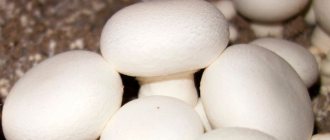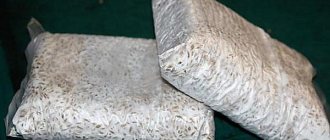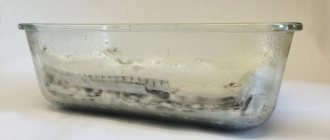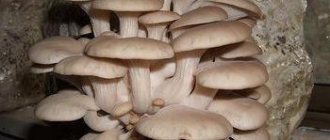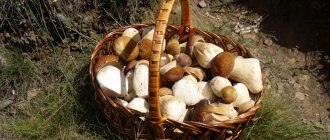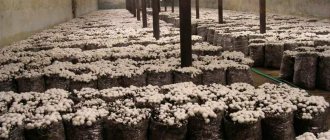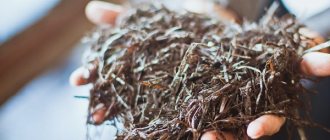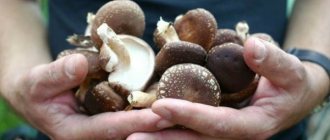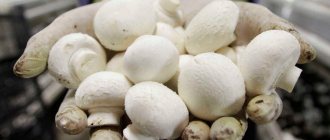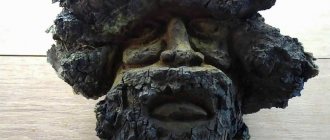If you decide to start growing mushrooms, then you need to start by purchasing mycelium. You can buy it in a store and not waste time and effort on growing it, but in this case there is no guarantee that the mycelium was produced under sterile conditions, and this factor is decisive for its further development and fruiting. Growing champignon mycelium at home is a guarantee of quality. However, it is necessary to acquire special equipment, as well as prepare several rooms in which the mycelium will develop at different stages.
Types of mycelium of champignons
To plant these mushrooms at home, grain and compost mycelium are used.
Champignon grain mycelium is often used for propagation. It is more convenient to sow and does not require additional processing. Such mycelium can be stored for 6 months at +4 degrees. Its substrate always includes grain.
Compost mycelium has a lower yield, but has increased resistance to external influences. This variety will keep for about 3 weeks at room temperature. It is grown on organic fertilizers.
Disinfection
Before you start growing champignons, you should thoroughly disinfect the basement to prevent the appearance of mold and parasites. Do not neglect this procedure, because champignons react very sensitively to various diseases and pests. Due to laziness or neglect of preventive measures, you can lose a significant part of the harvest even at the initial stage of the process.
To fully process the basement you need to do the following:
- fumigated with sulfur bombs;
- whitewash the ceilings and walls with a mixture of lime and copper sulfate;
- spray with 4% formaldehyde solution;
- if after storing vegetables in the basement there are fruit flies, it should be treated with chlorophos;
After disinfection is completed, the basement is thoroughly ventilated so that both the mushrooms and people feel comfortable.
Preparing for landing
When planting champignon mycelium, you need to pay attention to the quality of the mycelium. The future harvest depends on this factor.
Next, you should choose a place to grow. This could be a cellar, basement, balcony, barn, greenhouse.
It is very important that the selected room has good ventilation. And air humidity should not exceed 85%. Before planting, it is necessary to carry out disinfection by spraying the floor and walls with formaldehyde or lime.
Division into zones
If the cellar is spacious, then it can be divided in half. In one half they set up an incubator for the mycelium (they spread it over the substrate), and in the second half they expel the mushrooms. For these processes to be successful, different temperatures are needed. The mycelium develops at + 23 degrees C, and mushrooms grow at a temperature of + 16-17 degrees C. By maintaining a constant temperature in each zone, you can simply move the container with the substrate, establishing a continuous process for growing champignons. If space allows, you can arrange a third zone where compost will be prepared.
How to prepare the substrate?
The substrate for champignon mushroom mycelium consists of manure and straw. Their ratio should be one to three - the main part of the first and the third part of the second substance. Both components must be of high quality. Additionally, you can add water, gypsum, chalk, and urea. The room in which the nutrient medium is prepared must have good ventilation.
In addition, you can prepare a substrate from agar and other available components - carrots or oats
To prepare carrot agar, you need to finely chop fresh carrots, add water and boil for 30 minutes. Strain the resulting substance, mix with water, agar and jelly.
Oatmeal agar is prepared by mixing oatmeal, water and agar. The resulting mixture should be boiled for an hour and stirred regularly.
Growing conditions
How to successfully grow champignon mycelium? For successful germination after planting and a high yield of these mushrooms, the following factors are necessary:
- the air temperature should be from +12 to +20 degrees, and the soil +15...17 degrees;
- humidity 65-85%;
- low room illumination;
- absence of drafts;
- good ventilation;
- content of cellulose, calcium, organic elements, nitrogen, potassium, phosphorus in the substrate;
- slightly alkaline reaction of the nutrient medium.
What should the cellar be like?
You can grow mushrooms in any well-made cellar. The floor in the cellar should be concrete, not earthen. In general, the cleaner and more insulated from external influences the room is, the better.
To save space in the basement, racks with mushrooms are arranged in several floors (tiers).
Lighting
Unlike green onions and other plants, champignons do not need additional lighting. They can be grown perfectly in the dark. The light bulb should be screwed in only to make it convenient to work in the cellar or basement.
Ventilation
The cellar must be equipped with a ventilation system, since the compost on which the champignons grow actively releases carbon dioxide during decomposition. But mushrooms cannot tolerate mustiness. Carbon dioxide must be removed and fresh air supplied in its place. However, drafts should not be allowed. The ventilation pipes are covered with fine mesh to prevent insects from getting inside.
If conventional supply and exhaust pipes are not enough for good ventilation of the cellar. You will have to take care of forced ventilation of the room. To organize air circulation above the boxes with champignons, you can use additional fans. If possible, it is worth installing additional air purification filters.
Temperature and humidity
To monitor these indicators, install a thermometer and hygrometer in the room for growing champignons. You can increase the humidity by spraying the shelving and floors with a spray bottle. Reduce through ventilation.
The temperature in the summer can be regulated with the help of ventilation, but if you plan to grow champignons all year round, take care of additional heating of the cellar.
Space zoning
If your cellar is large enough, it makes sense to divide it into two zones. You will use one room for incubation (spread of mycelium over the substrate), and the second for direct forcing of mushrooms (fruiting bodies). The temperature required for the successful completion of these processes is different. The mycelium grows at approximately 23 degrees, and fruiting occurs at 16–17 degrees.
By maintaining stable temperature conditions in each room, you can simply move the boxes with the substrate. In this way, you can grow champignons continuously - while half of the boxes bear fruit, mycelium grows in the other, and so on. If necessary, you can add a third zone for composting.
Pre-disinfection
To grow mushrooms, the basement must be thoroughly disinfected and treated against parasites and mold. Champignons are very sensitive to diseases and pests, and it would be a shame to lose most of the harvest due to neglect of safety measures at the initial stage.
In particular, the following processing can be carried out:
- Fumigate with a sulfur bomb.
- Whitewash the walls and ceiling with lime and copper sulfate.
- Spray with a 4% formaldehyde solution.
- If there were previously vegetables in the basement, and fruit flies or other pests have infested, you need to treat the room with chlorophos.
- As an additional protective measure, you can place a box of sawdust soaked in a disinfectant solution at the entrance.
After disinfection, the basement should be thoroughly ventilated, otherwise it will be very difficult not only for the champignons, but also for you to stay inside.
How to plant mycelium?
To plant grain and compost mycelium, you need to perform the following steps:
- Warm the compost slightly to 27 degrees.
- Place it in a container. The layer height should reach 30 cm.
- Make holes at a distance of 20-25 cm from each other.
- If the mycelium is grain, you need to sprinkle it in a thin layer, and if it is compost, then distribute it in small handfuls.
- Sprinkle the mycelium a little with soil. The cover soil layer should be at least 2 cm to ensure good yield.
- Cover the container with plastic wrap.
- After a white coating appears, remove it and cover the substrate with straw or moss.
On the 3rd or 4th day, it is recommended to slightly loosen the mycelium to improve air circulation. At the same time you can start watering it. Watering itself should be fractional. When watering, you need to make sure that the boundary between the top layer and the compost remains moist.
Ventilation
A ventilation system is installed in the cellar, because large quantities of carbon dioxide are released from the compost. Mushrooms absolutely cannot tolerate a musty smell, so carbon dioxide must be removed from the basement, and fresh air must be allowed into the basement instead. At the same time, you need to ensure that there are no drafts. Ventilation pipes must be covered with a fine mesh to prevent various insects and other unwanted guests from entering the basement.
If this ventilation is not enough for good ventilation, forced ventilation of the cellar should be arranged. To organize air vibrations above the mushrooms, additional fans are installed. You can install filters to purify the air.
Pest prevention
To successfully grow mycelium at home, it must be protected from pests and diseases. To do this, you need to periodically perform the following steps:
- Regularly disinfect the premises;
- Carry out timely replacement of soil;
- Maintain recommended planting conditions;
- Follow the rules for planting and preparing the substrate.
Beneficial features
- Mushrooms normalize blood pressure;
- regulate blood cholesterol levels;
- have a beneficial effect on the immune system;
- prevent the occurrence of cancer;
- improve the condition of skin and hair;
- prevent premature aging;
- help get rid of excess weight;
- promote accelerated regeneration of damaged areas.
Interesting Facts
- These are the first mushrooms to be grown in an artificial environment.
- Champignons are widely used in cosmetology. Lotions and masks based on these mushrooms are great for helping with skin problems.
- This type of mushroom is used in medicine and is a good aid in the fight against bronchial pathologies and diabetes mellitus types 1 and 2.
- Champignons contain chemicals that relieve headaches, help in the treatment of hepatitis and various forms of tuberculosis.
Basic information
Champignon from lat. Agaricus came from the genus Agaricales of the Champignon family (Agaricaceae). From French, the word “champignon” is translated as “mushroom”.
There are several types of champignons, which differ in color and surface structure, which can be smooth or fibrous. This mushroom grows in moist soil rich in organic matter.
Science identifies three main groups of champignons:
- field plants growing in desert spaces,
- forest, found on forest edges,
- herbophiles, the place of origin of which is grass.
The champignon is easy to recognize; in appearance it resembles a small ball. Its description is simple: the cap is dense, covered with soft scales, the color is white, beige or brown. On the inside there are white plates; as the mushroom ages, the scales become brown. The leg is smooth, dense in structure, the color of the pulp can be white or pink.
Popular articles The use of fir oil for leg fractures
